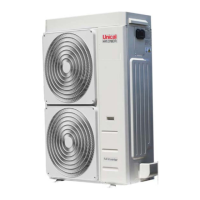29
The following leak detection methods are suitable for plants with
flammable refrigerant:
Leak detection by electronic refrigerant leak detector:
■ Electronic refrigerant leak detectors may not have the required
sensitivity or may need to be calibrated for the relevant range.
Perform the calibration operations in an area free of refrigerant.
■ The leak detector must be suitable for the detection of R32
refrigerant gas.
■ The leak detector must not contain any ignition source.
■ Calibrate the leak detector according to the refrigerant used.
response threshold to <3 g / a, suitable for propane.
Leak detection by leak detection liquids:
■ Leak detection liquids are suitable for use with most refrigerants.
Please note that
The chlorine contained in some leak detection liquids can react with
the refrigerant. This can cause corrosion.
Do not use leak detection liquids containing chlorine.
Necessary measures in case of leakage from the cooling circuit:
■ Immediately extinguish any open flame near the heat pump.
If it is necessary to carry out soldering / soldering operations to repair
the leak, it is always necessary to remove all the refrigerant from the
cooling circuit. Before and during tin soldering / soldering operations
with oxygen-free nitrogen, expel the refrigerant from the area to be
soldered / soldered tin.
3
Removal and evacuation
When working inside the refrigerant circuit to carry out repairs or for any
other reason, conventional procedures must be followed. However, it is
t to follow best practice as there is a danger of flammability is a
lity. The following procedure should aim to:
remove the refrigerant fluid;
purge the circuit with an inert gas;
evacuate;
purge again with an inert gas;
open the circuit by cutting or by brazing.
The charge of the refrigerating fluid must be kept
in the appropriate
guard cylinders. The system must be "cleaned" with OFN to make the unit
safe. It may be necessary to repeat this process several times.
Compressed air or oxygen
should not be used for this work.
Cleaning is obtained by interrupting the
vacuum condition in the system
with OFN and continuing to fill until the operating pressure is reached,
creating an outlet towards the atmosphere and, finally, recreating the
vacuum
condition. This process must be repeated until there is no trace
erant fluid in the system. When using the last OFN refill, the
system must be at atmospheric pressure to allow it to be able
to work. This operation is of vital importance in the ev
ent that it is
necessary to carry out brazing operations on the pipe networ
k.
of the ignition sources the outlet duct of the
depressurization pump is not closed and that there is ventilation.
In addition to conventional charging procedures, the following
requirements must be adhered to.
- Make sure that when using a refill equipment, contamination between
different refrigerant fluids does not occur. Hoses or pipes must be as
short as possible to minimize the amount of refrigerant fluid they

